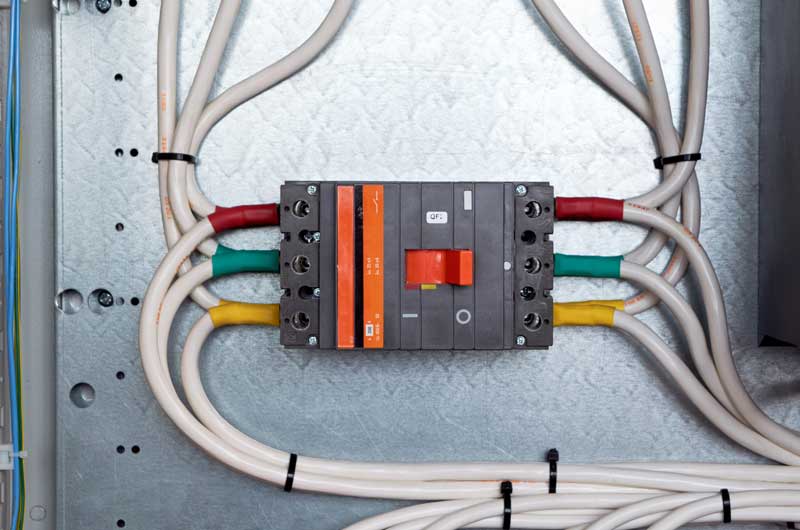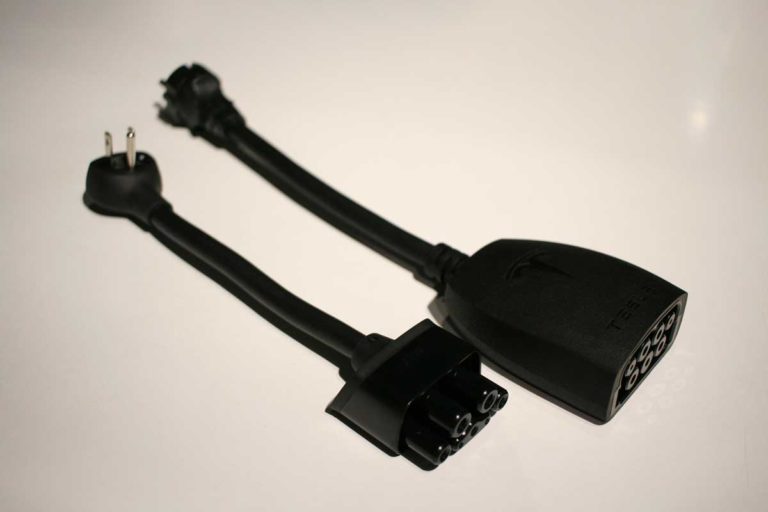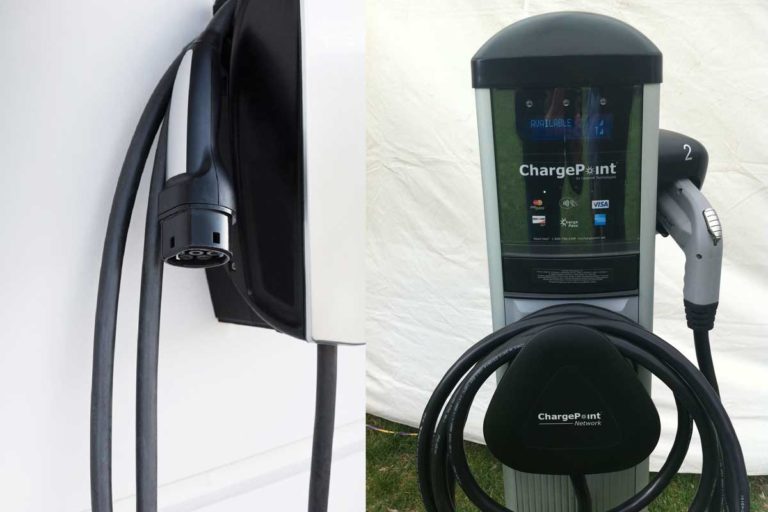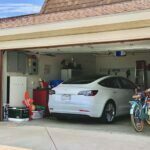OK, the answer to this question is quite technical, but it really does depend on a few factors.
Consider your Tesla’s charging capability and your chosen power levels. For minimum power, use a #14 Gauge AWG wire size, which charges at 7-10 mph with 12 amps and 2.8kW. For maximum power and charge speed use #6 Gauge which charges at 34-42 mph with 48 amps and 11.5kW. Use 90°C -rated Copper THW.
For a less techy explanation, check out the rest of the the article. For now, just know that the higher the AWG number the smaller the wire size. What?!
I also added 2 easy-to-use calculators in this article. One will help you calculate the load on a circuit to see if it is excessive. You can also calculate the minimum circuit breaker size for the given load. The other will calculate the power capacity when using Volts, Amps and Watts numerics. Check it out!
- Understanding the Importance of Breaker Size
- Things To Consider When Choosing a Breaker Size for a Tesla Charger
- Calculating the Breaker Size
- Additional Considerations for Breakers
- Choosing The Correct Breaker Size
- What Amp Size Do I Need for a Tesla Charger?
- How Many Amps is a Tesla Charger?
- Frequently Asked Questions
- How To Wire a Tesla Wall Charger
- EV Speedy's Take
Understanding the Importance of Breaker Size
Before we dive into the specifics, let’s grasp the significance of the breaker size itself. Think of a breaker as a guardian angel for your electrical system.
It’s responsible for protecting against overloads and faults that can lead to dangerous situations. Choosing the right breaker switch size ensures your charging experience is safe, efficient, and hassle-free.
Things To Consider When Choosing a Breaker Size for a Tesla Charger
Now, let’s explore the essential factors to consider when determining the appropriate breaker box size for your Tesla charger.
Tesla Charger Specifications
First up, take a look at your Tesla charger’s specifications. Tesla offers different models, each with varying power ratings measured in watts or kilowatts.
The charger’s power rating directly influences the breaker size you’ll need. So, knowing this information is crucial.
Electrical Voltage
Next, let’s talk about electrical voltage. Most residential buildings in the United States operate at a standard voltage of around 240 volts.
The relationship between the charger’s power rating and the electrical voltage is vital when calculating the breaker size. It’s this interplay that helps determine the ampere (amp) rating needed.
Electrical Code and Regulations
Before proceeding further, keep in mind that local electrical codes and regulations may have specific requirements regarding breaker sizes.
To ensure compliance with these regulations, it’s highly recommended to consult with a licensed electrician. They’ll be familiar with the local codes and can guide you accordingly.
It’s also important that you don’t fiddle with electrical boxes if you don’t have any electrical experience! Rather hire a professional who has the correct tools and knowledge.
Calculating the Breaker Size
Now, let’s crunch some numbers to answer your question, “What size breaker do I need for a Tesla charger?”
Calculating the breaker size involves a simple formula:
Breaker size (in amps) = Charger power rating (in watts) / Electrical voltage (in volts)
For example, if your Tesla charger has a power rating of 14.4 kW and the electrical system operates at 240 volts, the calculation would be:
Breaker size = 14,400 W / 240 V = 60 amps
In this scenario, a 60-amp breaker would be suitable for your charger.
Additional Considerations for Breakers
While the above formula provides a useful starting point, it’s essential to be aware of other factors that might influence the breaker size.
Wire gauge, wire length, and specific electrical code requirements can impact the overall setup. To ensure a safe and accurate recommendation tailored to your specific needs, it’s wise to consult with a qualified electrician. They’ll evaluate your electrical system and provide personalized guidance.
When choosing a breaker needed for a Tesla charger, you can also consider the following factors.
Consider Your Desired Charge Rate
The standard way to measure charge rate is the charge per hour – for example, the standard you should be looking to have is around 40 miles per hour (64 kph). This, of course, will differ depending on the charging method you use for your vehicle.
There are numerous ways to charge a Tesla: at work, at home, or using portable devices on the road.
If we focus specifically on the requirements to charge at home, we’re looking at you getting 44 miles (70.8 km) of travel distance out of around an hour of charging. Wall charging is the fastest speed for home or office charging options and gives you the most range in a set amount of time.
Looking at other options offers varying results – let’s lay them out in table format so you can tell the difference the charge rate makes.
| Hardware | Charge rate |
| Wall connector | 1 hour charge = 44 miles (70.8 km) |
| Mobile connector + 120V outlet adapter | 1 hour = 3 miles (4.8 km) |
| Mobile connector + 240 V outlet adapter | 1 hour = 30 miles (48.2 km) |
| Supercharger | 15 minutes = 200 miles (321.9 km) |
| Destination charger | 1 hour = 44 miles (70.8 km) |
The charging speeds do vary, depending on the % charged level of your car battery. The longer it gets charged, the slower it charges. Clearly, some charging methods are better than others. One hour charge time to move 3 miles? Nobody has time for that!

“And what will this cost me?” I hear you ask with a clenched jaw. Well, it doesn’t have to break the bank! Watch this Alex Sibila YouTube video about what it costs to charge a Tesla, how you can reduce this cost, and how to factor charge rate into these equations.
As an added bonus to this article, I’ve created this easy-to-use charging calculator. Simply input your model, charging wattage, and charging percentage, and you will get the estimated time it will take to charge a Tesla in terms of hours. You can play around with numbers a bit just to see how charging time changes:
What Electric Service Size Is Needed?
Whoever said size doesn’t matter was lying or did not have a Tesla.
Electric service size refers to the amount of electrical power that a building or property can handle. It’s like the capacity of the electrical system. We measure service size in terms of amperage (amps), which basically tells us how much electrical current can flow into the place.
For residential properties, service sizes can range from 100 amps to 400 amps. A common size for many homes is around 200 amps. Commercial and industrial buildings may need even larger service sizes because they often use more electrical power.
To figure out the right service size for a building, an electrician considers things like the size of the place, the number of electrical circuits needed, and the types of appliances and equipment that will be used.
A 50 amp service breaker charges at a rate of about 23 miles per hour (37 kph) using a 240-volt outlet. This is about the same as what you’d get with an electric stove. It doesn’t seem like much, but it’s honest work and the standard for Tesla breakers.
Determining Total Electrical Load to Choose a Circuit Breaker
We live always-on lives, hungry for power – electrical that is, don’t take that out of context.
Watts, volts, and amps: calculating the relationship between these is the key to determining the breaker you need to charge your Tesla without blowing out your other bulbs. Note that your total electrical load shouldn’t be more than 80% of capacity to avoid a circuit overload.
Below is a table that you can use to discern which calculation to use to determine capacity:
| Calculation | Example |
| Volts x Amps = Watts | 240 volts x 100 amps = 24,000 watts |
| Watts/Volts = Amps | 24,000 watts/240 volts = 100 amps |
This table shows how to determine the total electrical load of a household. This way, you can figure out how much voltage would need to be dedicated to charging your shiny toy.
Choosing The Correct Breaker Size
Before deciding on a breaker size, do calculations based on hypothetical total capacities: take the individual breaker capacity and compare it with the total capacity of all other household appliance usage. Once you have determined the appropriate breaker size, you can begin the installation.
Remember, you’re not alone! We have a fantastic invention called an electrician in this modern era, who is trained to help you with this. We don’t recommend you try to become a graduate of Wikipedia Academy and electrocute yourself – consult with professionals!
If you feel confident in your DIY abilities and want to spare the cost of hiring an electrician, you can pick up some extra tips and tricks from this TESBROS instructional YouTube video.
What Amp Size Do I Need for a Tesla Charger?
The amp size you need for a Tesla charger should be no more than around 60. This enables you to charge your Tesla without sacrificing electricity in any part of your home. You should check your user manual for guidance on what Tesla charger you need.
Do I Need a 200 Amp Service for a Tesla?
You don’t need a 200 Amp service for a Tesla. The max amount of amps you really need is around 60, especially considering the charger’s percentage of power from the overall power flow into your house.
Even if you decide on a 200 Amp service, you can’t use all of it at once. The most you can use at a time is around 160 Amps. Factored into this should be power taken by appliances and general household upkeep. No point in having a charged car and a dark house.
To check how many amps you need, you (unfortunately) have to do some quick maths: you can calculate the relationship between your power usage, the breaker amps, and the voltage of it all. There is a direct link between amps and wattage that is absolutely vital to consider!

What Size Wire Do I Need for a 60 Amp Tesla Charger?
Wire size, or wire gauge, is measured in American Wire Gauge (AWG). Professionals recommend an AWG of 4 to 6 for most household appliances, which includes (though a somewhat less common household appliance) Tesla chargers. The wire size for 60 amp 220V devices such as the Tesla charger is 4 to 6 AWG.
How Many Amps is a Tesla Charger?
So, when it comes to the amperage of a Tesla charger, it actually depends on the specific model and version you’re talking about. Tesla offers different chargers with various amperage options to suit different electrical systems and charging needs.
For residential charging, you’ll find common amperage options like 40 amps, 48 amps, 60 amps, or even higher. These amperage ratings correspond to different power levels, which can affect the charging speed of your Tesla.
Now, keep in mind that the amperage of the Tesla charger alone doesn’t determine the charging speed. Other factors come into play, like the power rating of the charger, the electrical supply available in your home or location, and the capabilities of your Tesla vehicle’s onboard charger.
To find out the specific amperage of a Tesla charger model you’re interested in, you can check the official Tesla website, review their product documentation, or reach out to a Tesla representative for accurate details.
When you plan to install a Tesla charger, it’s essential to involve a licensed electrician in the process. They can assess your electrical system’s capacity, help determine the appropriate amperage for your charger, and guide you on other crucial aspects like conduit, wall charger placement, panel compatibility, connection methods, and even the main breaker.
Remember, ensuring a proper and safe installation of your Tesla charger is key for efficient charging and peace of mind. So, don’t hesitate to seek professional assistance from an electrician to ensure everything is set up correctly.
Frequently Asked Questions
What Is a Tesla Wall Connector, Really?
Can You Use a Regular 110 Volt Outlet To Charge?
How To Wire a Tesla Wall Charger
So, you want to know how to wire a Tesla Wall Charger? No worries, I’ve got you covered. Let’s go through the process.
Phase: First, it’s important to note that Tesla Wall Chargers typically require single-phase power. Make sure your electrical system is set up for single-phase power before proceeding with the wiring.
Tesla Wall Charger: Start by unpacking your Tesla Wall Charger and familiarizing yourself with its components. The charger should come with clear instructions and a wiring diagram specific to the model you have.
Amp Circuit Breaker: Next, you’ll need to determine the appropriate amp circuit breaker for the Tesla Wall Charger. Refer to the charger’s specifications or the manufacturer’s guidelines to determine the recommended amp rating. This will help ensure safe and efficient charging without overloading the electrical system.
Wiring: Now, let’s get into the wiring process. Ensure that the power to the circuit you’re working on is turned off at the main breaker panel to prevent any electrical hazards.
- Mounting the Charger: Begin by mounting the Tesla Wall Charger on the wall, following the manufacturer’s instructions. Ensure it is securely and correctly installed.
- Electrical Connections: Take the necessary precautions when handling electrical wiring. Connect the wiring from the circuit breaker panel to the Tesla Wall Charger. Follow the wiring diagram provided with the charger for guidance on connecting the wires correctly. This may involve connecting the hot, neutral, and ground wires to their respective terminals.
- Grounding: Proper grounding is essential for safety. Connect the grounding wire from the circuit to the designated grounding terminal on the Tesla Wall Charger. This helps to protect against electrical faults and ensures safe operation.
Double-Check and Testing: Once the wiring connections are made, double-check all the connections to ensure they are secure and properly tightened. Afterward, turn on the power at the main breaker panel and test the Tesla Wall Charger to verify that it is functioning correctly.
Remember, if you’re unsure about any step or lack experience with electrical work, it’s always recommended to consult with a licensed electrician. They have the expertise to ensure a safe and code-compliant installation of the Tesla Wall Charger, giving you peace of mind while charging your Tesla vehicle.
EV Speedy’s Take
People often want to charge their EVs as quickly as possible at home and seem to think that it is somehow indicative of how well your EV- and charging system are set up.
All that really matters is safety for you and your family and longevity for your car. So, choose the safest options outlined in this article. You always have more time than you think to charge your car overnight.
Slow and steady charging speeds are the way to go. Most Americans don’t drive more than 50 miles per day on average.; you really don’t have to charge your car to a 100% every day.
Check out these 20 great gift ideas for yourself or a Tesla fanboy.
Contact Us if you have any questions or queries.







